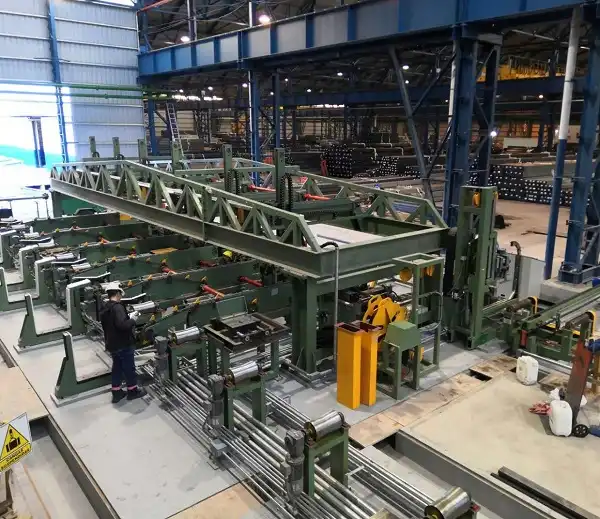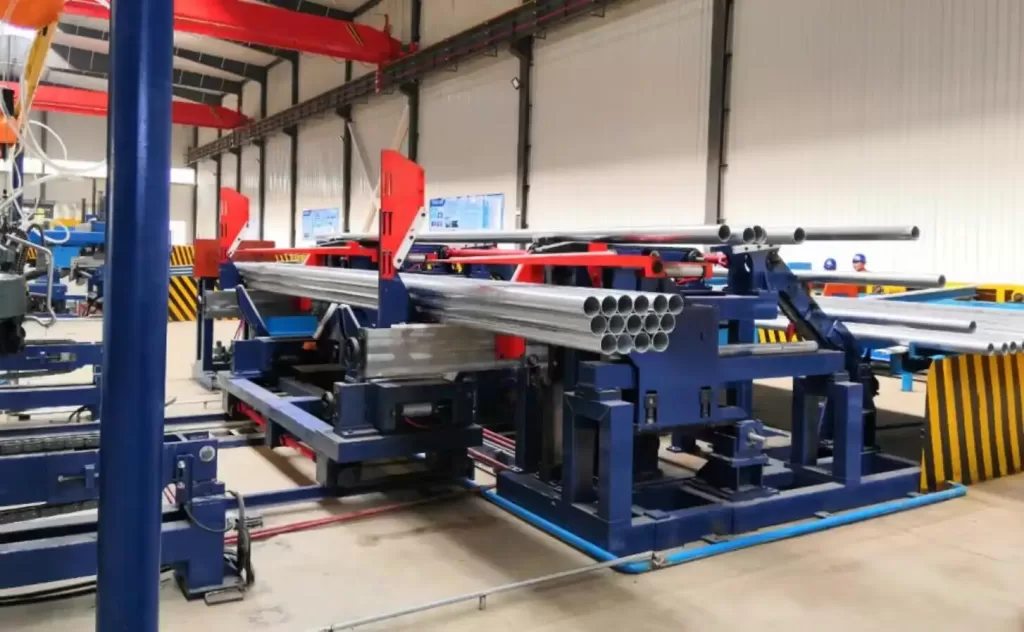Optimizing Your Steel Tube Packaging: A Guide to Bundling and Strapping Lines
Efficient and secure packaging is crucial in the steel tube industry to prevent damage during handling and transportation and to streamline logistical operations. Automated steel tube packing lines, incorporating bundling and strapping processes, are key to achieving these goals. This guide explores the steps involved and the technology behind modern steel tube packing systems.
Understanding the Steel Tube Packing Process
A typical automated steel tube packing line integrates several stages to transform loose tubes into securely strapped bundles ready for shipment. The core functions usually involve tube accumulation, layer forming, bundle shaping, and strapping.
1. Tube Feeding and Accumulation
The process begins with individual steel tubes being fed onto the line, often via conveyors or roller tables from upstream processes like cutting or finishing. An accumulation station gathers the required number of tubes needed for a single layer or the complete bundle, depending on the system's design.
2. Layer Formation and Bundle Shaping
Once enough tubes are accumulated, mechanical devices arrange them into layers. For subsequent layers, lifting mechanisms or transfer cars might be used. The system then forms these layers into the desired bundle shape – commonly hexagonal, square, or rectangular – ensuring tight and stable formation. This step often involves:
- Alignment Devices: Ensuring tubes are parallel and correctly positioned.
- Forming Heads/Jaws: Gently pressing the tubes into the specified shape.
- Adjustable Fixtures: Allowing for flexibility to handle various tube diameters and bundle sizes.

steel tube bundle strapping line 3. Bundle Transfer
The formed, but not yet secured, bundle is transferred to the next stage. This is typically done using driven rollers, chain conveyors, or pusher mechanisms, ensuring the bundle maintains its shape during movement.
4. The Strapping Stage
This is a critical step for securing the bundle. Automated strapping machines apply straps at predetermined positions along the bundle's length. The process usually involves:
- Strap Feeding: Dispensing the strap material (often steel or PET) around the bundle.
- Tensioning: Pulling the strap tight to a pre-set tension level to ensure stability without damaging the tubes.
- Sealing: Joining the strap ends, typically through welding (for PET) or mechanical crimping/notching (for steel).
- Cutting: Severing the strap from the supply roll.
Modern steel tube strapping packing line systems can apply multiple straps simultaneously or sequentially for enhanced efficiency.
5. Bundle Discharge
Finally, the securely strapped bundle is discharged from the packing line, often onto exit conveyors, roller tables, or designated collection areas, ready for storage or shipping.
Key Technologies in Automated Steel Tube Packing Lines
Modern packing lines leverage various technologies to ensure efficiency, reliability, and safety:
- Programmable Logic Controllers (PLCs): The central control unit managing sensors, motors, and actuators, allowing for automated sequences and parameter adjustments.
- Human-Machine Interface (HMI): Touchscreen panels providing operators with intuitive controls for setup, operation monitoring, and troubleshooting.
- Sensors: Photoelectric, proximity, and laser sensors detect tube presence, position, and bundle dimensions, ensuring accurate operation and preventing collisions.
- Conveyor Systems: Roller, chain, and belt conveyors facilitate smooth material flow throughout the line.
- Variable Speed Drives: Allow for precise control over conveyor and machine speeds to match production requirements and ensure gentle handling.
- Safety Features: Light curtains, emergency stops, safety interlocks, and protective guarding are essential for operator safety.

steel tube bundle strapping machine Advantages of Automated Steel Tube Packing Systems
Implementing an automated packing line offers significant benefits:
- Increased Throughput: Automation drastically speeds up the bundling and strapping process compared to manual methods.
- Consistent Bundle Quality: Ensures uniform bundle shapes and consistent strap tension, leading to more stable and secure packages.
- Reduced Labor Costs: Minimizes the need for manual handling and strapping, freeing up personnel for other tasks.
- Enhanced Safety: Reduces manual lifting and interaction with strapping tools, lowering the risk of workplace injuries.
- Improved Product Protection: Secure, well-formed bundles minimize tube movement and potential damage during transit.
- Versatility: Many systems can be adjusted to handle a range of tube sizes (round, square, rectangular) and bundle configurations.
Considerations When Implementing a Steel Tube Packing Line
When selecting or designing a packing line, consider factors such as:
- Tube Specifications: Diameter range, length range, wall thickness, and tube shape.
- Bundle Requirements: Desired bundle shape, dimensions, and weight.
- Throughput Needs: The required number of bundles per hour or shift.
- Strapping Material: Choice between steel strapping (high strength) and PET strapping (corrosion-resistant, safer handling).
- Level of Automation: From semi-automatic systems requiring some operator input to fully automated lines.
- Integration: How the packing line will connect with upstream and downstream processes.
- Floor Space and Layout: Ensuring sufficient space for the equipment and material flow.

steel tube packing line2 Conclusion
Automated steel tube packing lines represent a significant advancement in operational efficiency and product handling within the steel industry. By systematically organizing, bundling, and strapping tubes, these systems reduce manual labor, enhance safety, ensure package integrity, and contribute to a smoother, more productive workflow from production to final delivery. Understanding the process steps and underlying technologies helps in selecting and implementing the right solution for specific manufacturing or distribution needs.

